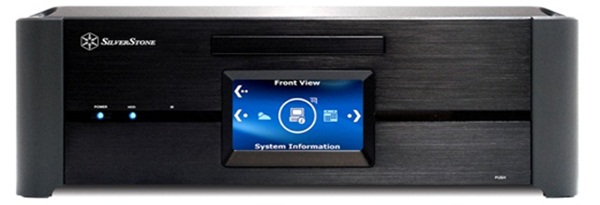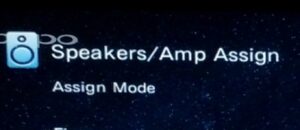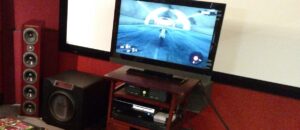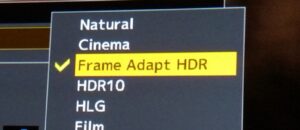During this last summer, I came to the conclusion that I need a better system for managing my movie collection. Yet I need to do something without bringing in more furniture, because the room’s looking a bit crowded. This is one of the challenges of the home theater hobby, arranging and designing an HT room without the clutter and mess, be it the physical media or the hundreds of cables hidden from view. After some reading (and also finally accepting that we’re living in a digital age), I decided to simplify everything with an HTPC (home theater personal computer).
One of the great things about these machines, and what essentially sold me on them, is having a large assortment of movies all in the same space without the clutter of physical discs or furniture. Essentially, an HTPC is one of the best space-savers you could imagine, when it comes to owning movies. Better still, I can retrieve and watch any movie without sifting through my stuff or getting off my chair. Everything is accessible with the push of a button on my remote. Don’t get me wrong, I’ve always enjoyed looking and being available to hold in my hands what I own ever since the days of VHS. But after finally experiencing an HTPC firsthand, I wonder what took me so long to switch. Even more surprising, I really don’t miss popping a disc into the player and waiting through all the warnings and trailers. I love this so much more!
It had been a while since I last built a computer system, mostly because I switched over to name brand laptops several years ago and pretty much never looked back. So, part of the challenge was just catching up on the latest developments and changes in technology. Most important, of course, was reading about all the available options, particularly in pricing. There are a number of ways for transforming a computer into a home media station, and plenty of retailers available to put it together with the proper software ready to use out of the box. Unfortunately, such conveniences come at a hefty price.
Then again, if you don’t feel all that comfortable with the inside of computers, which can be rather intimidating and confusing if you don’t know that much about them, this option definitely has an advantage. Arguably, one of the leading high-end companies in this area — or at least one of the best known brands due to last year’s lawsuit — is Kaleidescape Systems. Kaleidescap servers and players seem like great products, but I’ll never know because the prices are far too rich for my blood. On the other hand, the rates are far more reasonable than the exceedingly outrageous costs of nJoy’s media centers.
Another high-end solution comes from Vidabox, a company with an incredible selection and prices that better match the actual product received. One attractive feature is flexibility and customization. The cost of the machine depends on your precise needs and wants. You can customize specifically how you expect to use it in your house and home theater. For those already familiar with CQC Systems, you should know what you’ll get from the products of Vidabox, which is basically an extension of that particular software platform. It’s an HTPC solution for fully automated households. This is not just a media server. Again, as great as it sounds, I doubt that I’ll ever be able to afford something that can make my computer talk to the rest of the house, and tell the toilet when to flush while setting the house alarm, closing the shades, and keeping every room at a comfortable temperature.
Coming in at slightly more reasonable prices are two other machines with that same flexibility and customization, but which require a little more hands-on knowledge of the PC. First, with a bit more damage to the wallet, is a standalone NAS (Network-Attached Storage) server like Synology. Normally used as a central workgroup data storage, the company offers a great variety of choices with high performance products up to 100TB. The drawback is having to modify the Linux-based device (which also means a level of comfort on your part using that particular OS) into a media server on your own. You’ll also need to familiarize yourself with the applications and programs, which are available for anyone wanting to go this route. The end result, from what I’ve read in a couple forums, is well worth the learning experience.
The second option is likely the most attractive for those considering a home media server – and it comes in the best available prices. The Popcorn Hour is essentially like a network-capable media jukebox. It’s fully functional out of the box — ready to record your media collection as long as you’re comfortable doing a little hardware installation on your own. What you basically pay for is the computer case with power supply, motherboard, audio/video capabilities, CPU, memory and the necessary software. You will still need to purchase and install the Blu-ray/DVD drive and a 3.5″ HDD. The fine folks from Home Theater Forum provide a nice, quick review of the company’s A210 model here.
In the end, after quite a bit of research, I decided to go with our friends over at AVSForum, where you will find a discussion forum dedicated entirely to HTPCs. One thread that caught my attention was Assassin’s Simple Beginner’s Guide, which guarantees the best option at the most affordable price depending on your needs. I figured why not, since we’re living in a little more cost-conscious society at the moment. The results, as long as you follow his guide precisely, are absolutely remarkable! In terms of flexibility and 100% customization, there is no better way of having an HTPC than building it yourself with a terrifically helpful guideline by your side. For those not comfortable constructing your own computer and piecing hardware together, Assassin also does custom jobs at excellent prices via his storefront web site. I highly recommend his advice for anyone considering a home media server.
Next time, I’ll list the actual components that I decided to purchase, and discuss my experience putting the whole thing together. I had a blast building this wonderful machine and love the final outcome. I’m even considering a second, smaller build for the bedroom. But first, I’ll finish talking about this one, which fits in perfectly with the rest of my setup.
[UPDATE: Just to add a couple more options for those interested in an HTPC, Low Carbon PC and Lenovo’s latest machine have some very competitive prices.]






William Henley
I built my own. I have put the parts together over about the past two years, so prices may vary
The case I picked up from Geeks.com for about $25. They don’t have mine anymore, but any good ATX case should be fine.
I got my power supply from them as well. I don’t remember off the top of my head, but I think I paid about $20 for a 650 watt, which is a pretty good price. A power supply like that at the store will run you around $60-$100. You really do not want to go less than that.
Once again, its been a while since I bought it, but I think my motherboard is a Biostar TA890GXB HD. I got it in a combo with my processor, an AMD Phenom IIx6 1055 processor (this is a 2.8 Ghz six-core processor). The combined price of the motherboard and processor was $200.
My video card is an nVidia GeForce GT 430. I think I paid $50 for this. It does video acceleration beautifully, and is fast enough to play most modern games. I will actually sometimes play my PC games on my television, so I needed a card fast enough to handle 1920×1080 on my games. While this card isn’t the fastest on the market, I am not a big gamer, and this card is plenty fast for the games I play.
Of course, some of my games are older, so this required going online and finding patches, or how to hack INI files, to get my games to at least display in a 16×9 resolution. Not all games will scale up to 1920×1080, but at least I can play most games without stretching them.
I got a 12 foot HDMI cable from amazon for like $5. This hooks the video card up to my reciever, so the video card handles my 7.1 audio.
The most expensive thing I bought was a Blu-Ray writer, which was $129 on some sale. Don’t think I am pirating movies – I bought a great camera last year that also shoots 1080p30. First thing I did was take it to Disney World, and I got 35 gig of data. I took my friend’s kids out a few months ago and did a few photo shoots, and ended up with about 20 gig of pictures and videos of the kids. Blu-Ray discs are the most practical way to back stuff up.
I got 8 gig of ram in here, and with current ram prices, that runs about $80. The ram is because I will also do HD video editing on this system.
Because of my video editing hobby, I also have to have tons of harddrive space. I currently have about 3TBs in the computer over 4 harddrives. Some of these harddrives I have had for a while, and pretty much, when one goes out, I just replace it with one much bigger. I currently have 2 SATAs (one 750 TB and one 1.5 TB), an external 300 gig, and an older IDE that has an IDE to SATA connector on it (I believe that is a 200 gig). Oh, it looks like I got another 350 gig SATA in there as well. The bad thing about having all these drives in your case is that it can make it REALLY hard to work with stuff on the motherboard, and I sometimes have to play some tricks (unusual mounting of harddrives) to keep my harddrives from hitting my video card.
I also have three case fans in this thing. I live in Texas, and it gets HOT in the summer – especially this summer when I froze up my A/C unit more than once. Even with the three fans, there was a couple of times I had to shut down the PC this summer because it just got too hot and was overheating.
I also installed a card reader in the thing this past summer. That was about $12
Lastly, I got me a remote. it has a little infa-red USB dongle, and then has a pretty good remote.
M. Enois Duarte
AuthorFor the sake of providing as many options as possible, there is also Low Carbon PC and Lenovo’s IdeaCentre Q180. Links are provided above.